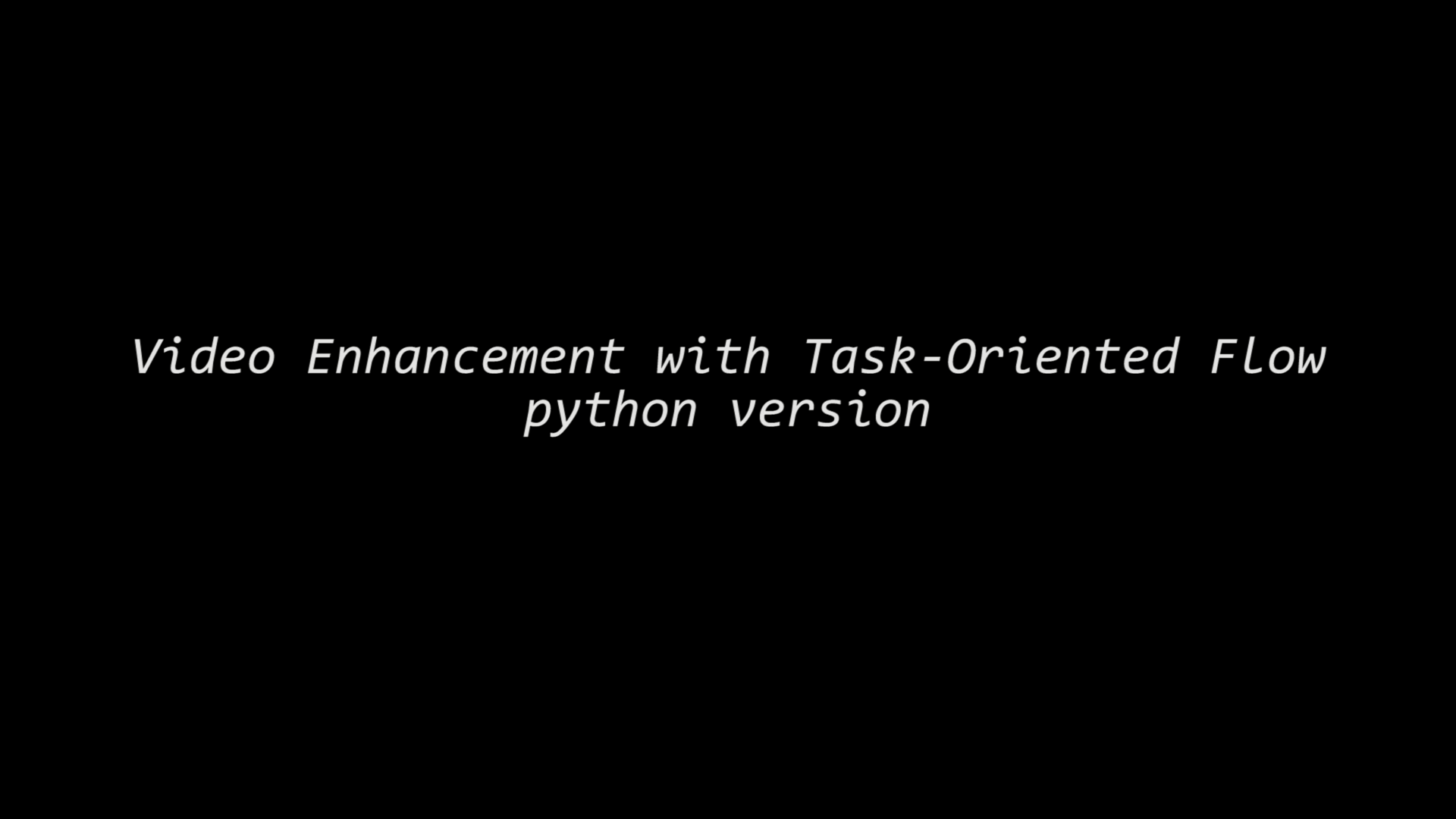Coldog2333 / Pytoflow
Programming Languages
Projects that are alternatives of or similar to Pytoflow
pyTOFlow
This repository is based on the paper 'TOFlow: Video Enhancement with Task-Oriented Flow'. It contains some pre-trained models and all of the codes we used including training code, network structure and so on.
What's more, you can describe it as the python version of the TOFlow presented there -> toflow
Note: There are still some TODOs should be done now, it is welcome to create a pull request to improve this repository. Let's make it better for fun and application!
Video Demo
Evaluation Result
Vimeo interp.
| Methods | PSNR | SSIM |
|---|---|---|
| TOFlow | 33.53 | 0.9668 |
| TOFlow + Mask | 33.73 | 0.9682 |
| pyTOFlow | 33.10 | 0.9631 |
Vimeo-Gaussian
| Methods | PSNR | SSIM |
|---|---|---|
| TOFlow | 29.10 | 0.9544 |
| pyTOFlow | 34.73 | 0.9518 |
Vimeo SR
| Methods | PSNR | SSIM |
|---|---|---|
| TOFlow | 33.08 | 0.9417 |
| pyTOFlow | 31.46 | 0.9230 |
Prerequisites
PyTorch
Our implementation is based on PyTorch 0.4.1 (https://pytorch.org/).
PIL and matplotlib
For loading images. Check on matplotlib v2.0.2, but it doesn't work on higher version of it like v3.1.0 (Noted that v2.0.2 is not the bar.) See Issue#6, Issue#7 for details.
opencv-python(cv2)
For processing videos.
CUDA [optional]
CUDA is suggested (https://developer.nvidia.com/cuda-toolkit) for fast inference. The demo code is still runnable without CUDA, but much slower.
FFmpeg [optional]
We use FFmpeg (http://ffmpeg.org/) for processing videos. That's ok if you don't have a FFmpeg, but maybe it will cost you lot of time to processing.
Installation
Our current release has been tested on Ubuntu 16.04 LTS.
Clone the repository
sh git clone https://github.com/Coldog2333/pytoflow.git
Install some required packages
Download tiny Vimeo dataset (1‰ of Vimeo-90K)
You would like to have a quick start to understand the whole features of pytoflow. Then you can download the tiny Vimeo dataset and have a try. The tiny Vimeo dataset is chosen randomly from the origin Vimeo dataset and the processed Vimeo-90K (mixed noise, blurred).
cd .
sh download_tiny_dataset.sh
unzip tiny.zip
Train
python3 train.py [[option] [value]]...
Options
- --task: training task, like interp, denoising, super-resolution. valid values:[interp, denoise, denoising, sr, super-resolution]
- --dataDir: the directory of the image dataset(Vimeo-90K)
- --ex_dataDir: the directory of the preprocessed image dataset, for example, the Vimeo-90K mixed by Gaussian noise.
- --pathlist: the text file records which are the images for train.
- --gpuID [optional]: No. of the GPU you want to use. default: no gpu.
- -h, --help: get help.
Examples
python3 train.py --task interp --dataDir ./tiny/vimeo_triplet/sequences --pathlist ./tiny/vimeo_triplet/tri_trainlist.txt --gpuID 1
python3 train.py --task denoising --dataDir ./tiny/vimeo_septuplet/sequences --ex_dataDir ./tiny/vimeo_septuplet/sequences_with_noise --pathlist ./tiny/vimeo_septuplet/sep_trainlist.txt --gpuID 1
python3 train.py --task super-resolution --dataDir ./tiny/vimeo_septuplet/sequences --ex_dataDir ./tiny/vimeo_septuplet/sequences_blur --pathlist ./tiny/vimeo_septuplet/sep_trainlist.txt --gpuID 1
Evaluate
python3 evaluate.py [[option] [value]]...
Options
- --task: training task, like interp, denoising, super-resolution. valid values:[interp, denoise, denoising, sr, super-resolution]
- --dataDir: the directory of the input image dataset(Vimeo-90K, Vimeo-90K with noise, blurred Vimeo-90K)
- --pathlist: the text file records which are the images for train.
- --model: the path of the model used.
- --gpuID [optional]: No. of the GPU you want to use. default: no gpu.
- -h, --help: get help.
Examples
python3 evaluate.py --task interp --dataDir ./tiny/vimeo_triplet/sequences --pathlist ./tiny/vimeo_triplet/tri_testlist.txt --model ./toflow_models/interp.pkl --gpuID 1
python3 evaluate.py --task denoising --dataDir ./tiny/vimeo_septuplet/sequences_with_noise --ex_dataDir ./tiny/vimeo_septuplet/sequences_with_noise --pathlist ./tiny/vimeo_septuplet/sep_testlist.txt --model ./toflow_models/denoise.pkl --gpuID 1
python3 evaluate.py --task super-resolution --dataDir ./tiny/vimeo_septuplet/sequences_blur --ex_dataDir ./tiny/vimeo_septuplet/sequences_blur --pathlist ./tiny/vimeo_septuplet/sep_testlist.txt --model ./toflow_models/sr.pkl --gpuID 1
Usage
python3 ./unstable/run.py --f1 ./unstable/example/im1.png --f2 ./unstable/example/im3.png --o ./unstable/example/out.png --gpuID 0
Options
- --f1: filename of the first frame
- --f2: filename of the second frame
- --o [optional]: filename of the predicted frame. default: out.png, saving in the same directory of the input frames.
- --gpuID [optional]: No of the GPU you want to use. default: no gpu.
References
- Xue T , Chen B , Wu J , et al. Video Enhancement with Task-Oriented Flow[J]. 2017.(http://arxiv.org/abs/1711.09078)
- Our SpyNet is based on sniklaus/pytorch-spynet
Acknowledgments
Thanks for the author of the origin paper @anchen1011, he gives me a lot of advice during the time I reproduce this paper and teaches me a lot. Then thanks for the School of Mathematics, Sun Yat-Sen University that provices me the computing server. I can do nothing without this powerful server. At last, thanks for the accompany of my teammates Qian and Junjie.
TODO
- A relatively poor but much more cheaper version of pytoflow for application.
For example, we can omit the last resnet layer that requires an extra system resources but only promotes a little improvement. After a comprehensive ablation analysis, we can convincingly determine which structures we can omit without dropping too much performance.
- To support the cases when batch size is larger than 1 while training and testing.
Maybe we can accelarate it with running more than 1 sequence of pictures at a time (using matrix multiplication, etc.)

